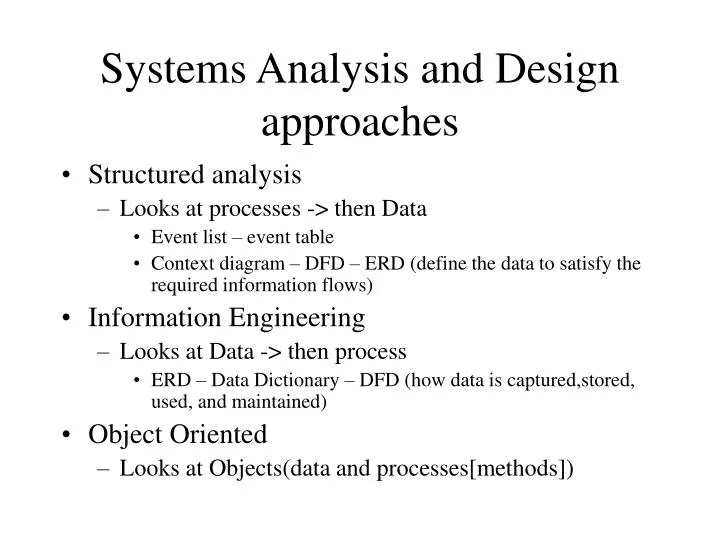Table Of Content

This chapter includes an in-depth section on using unified modeling language (UML). There is detailed coverage of the use case model, creating the class model diagram with UML, sequence diagrams, creating gen/spec diagrams, use case scenarios, and activity diagrams. Through several examples and Consulting Opportunities, this chapter demonstrates how to use an object-oriented approach. During feasibility studies and requirements engineering, systems analysts might use several kinds of tools.
Outputs and Inputs
The primary objective of systems analysis and design is to improve organizational systems. This tutorial provides a basic understanding of system characteristics, system design, and its development processes. It is a good introductory guide that provides an overview of all the concepts necessary to build a system. Study how organizations use computer systems and procedures and then design information systems solutions to help them operate more efficiently and effectively.
File Access
It has been said that if you can not document the artifacts of your work, you will probably fail. The Unified Modeling Language (UML) provides a very robust notation, which grows from analysis to design. It is a language used to specify, visualize, and document the artifacts of an object-oriented system under development.

Open or Closed Systems
The planning may also include how the user would like to solve the problem. Defining the scope of the problem is also important in this stage as well. Once the problem is determined, and one or more solutions have been selected, planning to implement the solution begins. Multiple scenarios may be enacted to determine the best course of action for implementing the system. It is the very first step in any system development and the critical phase where developers come together to understand the problem, needs, and objectives of the project. Secondly, I will describe an optimistic scenario in which I make some assumptions to arrive at a valuation similar to the current stock price.
It produces the working system by defining the design specification that specifies exactly what the candidate system does. It is concerned with user interface design, process design, and data design. With a finished SRS, the process advances to system design, which amounts to a phase for determining how to satisfy requirements.

Depending on the organization and methodology, at times, not every phase is carried out. Today, we’ll be looking at system design and system analysis topics through a comparative lens. We’ll explore what these processes are, how they fit into the broader system development life cycle, and how to differentiate them.
Computer Systems Analysis and Design
The 10th Edition reflects the rapidly changing face of the IS field and incorporates new technologies and innovations. Additional coverage of security and privacy issues and innovative materials on new developments, such as designing virtual reality and intelligent personal assistants, are included. So, in conclusion, we can say that system analysis is a problem-solving strategy that includes glimpsing at the more extensive system, breaking the separated parts, and sorting out how it works to accomplish a specific objective. Consequently, System analysis and design generally concentrate on Systems where there are several properties and elements of systems.
The word System is derived from Greek word Systema, which means an organized relationship between any set of components to achieve some common cause or objective. System analysis is conducted for the purpose of studying a system or its parts in order to identify its objectives. It is a problem solving technique that improves the system and ensures that all the components of the system work efficiently to accomplish their purpose.
Cadence moves into structural analysis with $1.2bn European buy ... - eeNews Europe
Cadence moves into structural analysis with $1.2bn European buy ....
Posted: Fri, 08 Mar 2024 08:00:00 GMT [source]
The concepts of usability, fit, perceived usefulness, and perceived ease of use are introduced, as is the Technology Acceptance Model (TAM), so that systems students can knowledgeably incorporate HCI practices into their designs. Chapter 14 also features material on designing easy onscreen navigation for Web site visitors. The chapter presents innovative approaches to searching on the Web, highlights material on GUI design, and provides innovative approaches to designing dialogs. Chapter 14 articulates specialized design considerations for ecommerce Web sites.
You will combine business practices with programming, applications and databases. You will be encouraged to further specialize with a minor in a specific field, such as healthcare, finance, agriculture or manufacturing. Your coursework within your first year includes information technology architecture, systems development and software development concepts. The major goal of systems analysis and design is to improve organizational systems.
Every record on the file is processed starting with the first record until End of File (EOF) is reached. It is efficient when a large number of the records on the file need to be accessed at any given time. Data stored on a tape (sequential access) can be accessed only sequentially. Also, when system analysis is implemented, it makes the software more flexible. System analysis makes managing the business easier and much more convenient.
Chapter 1 introduces the systems development life cycle (SDLC), the fundamental four-phase model (planning, analysis, design, and implementation) common to all information systems development projects. It describes the evolution of system development methodologies and discusses the roles and skills required of a systems analyst. The three roles of the systems analyst as consultant, supporting expert, and agent of change are introduced, and ethical issues and professional guidelines for serving as a systems consultant are covered. There is also material on virtual teams and virtual organizations, and the concept of HCI is introduced. Systems Analysis and Design is an active field in which analysts repetitively learn new approaches and different techniques for building the system more effectively and efficiently.
In the system analysis phase, analysts are concerned with outlining a proposed solution to a defined problem. In doing so, they consider how viable and effective the product is or will be. System analysts consider the system’s overarching goals, which they can then break down into components or modules to enable individual analyses. Before coding, there should be a understanding on pseudo, algorithm and the high level language(C, C++, C#, Java, etc.) you want to make use of.

No comments:
Post a Comment